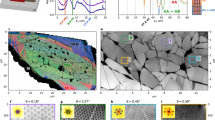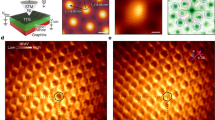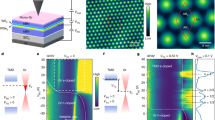Abstract
A single-walled carbon nanotube (SWNT) is a wrapped single graphene layer, and its plastic deformation should require active topological defects—non-hexagonal carbon rings that can migrate along the nanotube wall. Although in situ transmission electron microscopy (TEM) has been used to examine the deformation of SWNTs1,2,3, these studies deal only with diameter changes and no atomistic mechanism has been elucidated experimentally. Theory predicts that some topological defects can form through the Stone–Wales transformation in SWNTs under tension at 2,000 K, and could act as a dislocation core4,5. We demonstrate here, by means of high-resolution (HR)-TEM with atomic sensitivity, the first direct imaging of pentagon–heptagon pair defects found in an SWNT that was heated at 2,273 K. Moreover, our in situ HR-TEM observation reveals an accumulation of topological defects near the kink of a deformed nanotube. This result suggests that dislocation motions or active topological defects are indeed responsible for the plastic deformation of SWNTs.
This is a preview of subscription content, access via your institution
Access options
Subscribe to this journal
Receive 12 print issues and online access
$259.00 per year
only $21.58 per issue
Buy this article
- Purchase on Springer Link
- Instant access to full article PDF
Prices may be subject to local taxes which are calculated during checkout



Similar content being viewed by others
References
Terrones, M., Terrones, H., Banhart, F., Charlier J.-C. & Ajayan, P. M. Coalescence of single-walled carbon nanotubes. Science 288, 1226–1229 (2000).
Yoon, M. et al. Zipper mechanism of nanotube fusion: Theory and experiment. Phys. Rev. Lett. 92, 075504 (2004).
Huang, J. Y. et al. Superplastic carbon nanotubes. Nature 439, 281 (2006).
Yakobson, B. I. In Proceedings of the Recent Advances in the Chemistry and Physics of Fullerenes and Related Materials Vol. 97-42, 549–560 (The Electrochemical Society, Pennington, New Jersey, 1997).
Nardelli, M. B., Yakobson, B. I. & Bernholc, J. Mechanism of strain release in carbon nanotubes. Phys. Rev. B 57, 4277–4280 (1998).
Hashimoto, A., Suenaga K., Gloter, A. Urita K. & Iijima S., Direct evidence for atomic defects in graphene layers. Nature 430, 870–873 (2004).
Yudasaka, M. et al. Diameter enlargement of HiPco single-wall carbon nanotubes by heat treatment. Nano Lett. 1, 487–489 (2001).
Stone, A. J. & Wales, D. J. Theoretical studies of icosahedral C60 and some related species. Chem. Phys. Lett. 128, 501–503 (1986).
Perdew, J. P. & Wang, Y. Accurate and simple analytic representation of the electron-gas correlation energy. Phys. Rev. B 45, 13244–13249 (1992).
Xia, Y. et al. Growth and defect formation of single-wall carbon nanotubes. Phys. Rev. B 61, 11088–11092 (2000).
Dumitrica, T., Hua, M. & Yakobson, B. I. Symmetry-, time-, and temperature-dependent strength of carbon nanotubes. Proc. Natl Acad. Sci. USA 103, 6105–6109 (2006).
Ewels, C., Heggie, M. I. & Briddon, P. R. Adatoms and nanoengineering of carbon. Chem. Phys. Lett. 351, 178–182 (2002).
Ajayan, P. M., Ravikumar, V. & Charlier, J.-C. Surface reconstructions and dimensional changes in single-walled carbon nanotubes. Phys. Rev. Lett. 81, 1437–1440 (1998).
Banhart, F. Irradiation effects in carbon nanostructures. Rep. Prog. Phys. 62, 1181 (1999).
Ding, F., Jiao, K., Lin, Y. & Yakobson, B. I. How evaporating carbon nanotubes retain their perfection? Nano Lett. 7, 681–684 (2007).
Acknowledgements
Chuanhong Jin and C. Ewels are gratefully acknowledged for fruitful discussions. The work on microscopy is partly supported by Core Research for Evolutional Science and Technology (CREST).
Author information
Authors and Affiliations
Contributions
K.S. and S.I. conceived and designed experiments. K.S., H.W., M.K., Y.S. and K.U. performed the experiments and analysed the data. All authors discussed the results and commented on the manuscript.
Corresponding author
Ethics declarations
Competing interests
The authors declare no competing financial interests.
Supplementary information
Supplementary Information
Supplementary movie S1 (MOV 471 kb)
Supplementary Information
Supplementary movie S2 (MOV 482 kb)
Supplementary Information
Supplementary movie S3 (MOV 685 kb)
Supplementary Information
Supplementary movie S4 (MOV 279 kb)
Supplementary Information
Supplementary movie S5 (MOV 481 kb)
Supplementary Information
Supplementary figures S1-S7 and movie legends (PDF 293 kb)
Rights and permissions
About this article
Cite this article
Suenaga, K., Wakabayashi, H., Koshino, M. et al. Imaging active topological defects in carbon nanotubes. Nature Nanotech 2, 358–360 (2007). https://doi.org/10.1038/nnano.2007.141
Received:
Revised:
Accepted:
Published:
Issue Date:
DOI: https://doi.org/10.1038/nnano.2007.141
This article is cited by
-
Ferromagnetism in sp2 carbon
Nano Research (2023)
-
Experimental and DFT insights into nitrogen and sulfur co-doped carbon nanotubes for effective desulfurization of liquid phases: Equilibrium & kinetic study
Frontiers of Environmental Science & Engineering (2021)
-
Pile-up transmission and reflection of topological defects at grain boundaries in colloidal crystals
Nature Communications (2020)
-
Computational study on thermal conductivity of defective carbon nanomaterials: carbon nanotubes versus graphene nanoribbons
Journal of Materials Science (2018)



